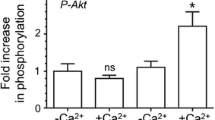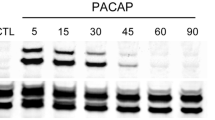Abstract
It has been well documented that protein kinase Cs (PKCs) play multifaceted roles in regulating exocytosis of neurotransmitters and hormones. But the isoform-specific PKC effects are still poorly elucidated mainly because of the large variety of PKC isoforms and the dubious specificity of the commonly used pharmacological agents. In the present study, based on overexpression of wild-type or dominant negative PKCε, we demonstrate in neuroendocrine PC12 cells that PKCε, but not PKCα, facilitates recovery of exocytosis after an exhausting stimulation. Specifically, PKCε mediates fast recovery of the extent of exocytosis in a phosphatidylinositol biphosphate-dependent manner, likely through enhancing the rate of vesicle delivery and reorganization of cortical actin network. In addition, PKCε promotes fast recovery of vesicle release kinetics that is slowed after a strong stimulation. These experimental results may suggest a PKC-dependent mechanism relevant to the short-term plasticity of exocytosis in both neurons and neuroendocrine cells.







Similar content being viewed by others
References
Akita Y (2008) Protein kinase C epsilon: multiple roles in the function of, and signaling mediated by, the cytoskeleton. FEBS J 275:3995–4004
Alessi DR (1997) The protein kinase C inhibitors Ro 318220 and GF 109203X are equally potent inhibitors of MAPKAP kinase-1 beta (Rsk-2) and p70 S6 kinase. FEBS Lett 402:121–123
Amatore C, Arbault S, Guille M, Lemaitre F (2008) Electrochemical monitoring of single cell secretion: vesicular exocytosis and oxidative stress. Chem Rev 108:2585–2621
Bai L, Zhu D, Zhou KM, Zhou W, Li DD, Wang Y, Zhang RY, Xu T (2006) Differential properties of GTP- and Ca2+-stimulated exocytosis from large dense core vesicles. Traffic 7:416–428
Barclay JW, Craig TJ, Fisher RJ, Ciufo LF, Evans GJO, Morgan A, Burgoyne RD (2003) Phosphorylation of Munc18 by protein kinase C regulates the kinetics of exocytosis. J Biol Chem 278:10538–10545
Berberian K, Torres AJ, Fang QH, Kisler K, Lindau M (2009) F-actin and myosin II accelerate catecholamine release from chromaffin granules. J Neurosci 29:863–870
Borst JGG, Sakmann B (1999) Depletion of calcium in the synaptic cleft of a calyx-type synapse in the rat brainstem. J Physiol Lond 521:123–133
Brager DH, Cai X, Thompson SM (2003) Activity-dependent activation of presynaptic protein kinase C mediates post-tetanic potentiation. Nat Neurosci 6:551–552
Burgos M, Calvo S, Molina F, Vaquero CF, Samarel A, Llopis J, Tranque P (2007) PKC epsilon induces astrocyte stellation by modulating multiple cytoskeletal proteins and interacting with Rho A signalling pathways: implications for neuroinflammation. Eur J Neurosci 25:1069–1078
Burgoyne RD, Morgan A (2003) Secretory granule exocytosis. Physiol Rev 83:581–632
Burrone J, Lagnado L (2000) Synaptic depression and the kinetics of exocytosis in retinal bipolar cells. J Neurosci 20:568–578
Chen P, Gillis KD (2000) The noise of membrane capacitance measurements in the whole-cell recording configuration. Biophys J 79:2162–2170
Chen P, Hwang TC, Gillis KD (2001) The relationship between cAMP, Ca2+, and transport of CFTR to the plasma membrane. J Gen Physiol 118:135–144
Cousin MA, Robinson PJ (2000) Two mechanisms of synaptic vesicle recycling in rat brain nerve terminals. J Neurochem 75:1645–1653
Doerner D, Alger BE (1992) Evidence for hippocampal calcium-channel regulation by PKC based on comparison of diacylglycerols and phorbol esters. Brain Res 597:30–40
Eitzen G (2003) Actin remodeling to facilitate membrane fusion. Biochim Biophys Acta Mol Cell Res 1641:175–181
Evanko D (2005) Primer: spying on exocytosis with amperometry. Nat Methods 2:650–650
Forsythe ID, Tsujimoto T, Barnes-Davies M, Cuttle MF, Takahashi T (1998) Inactivation of presynaptic calcium current contributes to synaptic depression at a fast central synapse. Neuron 20:797–807
Fujita Y, Sasaki T, Fukui K, Kotani H, Kimura T, Hata Y, Sudhof TC, Scheller RH, Takai Y (1996) Phosphorylation of Munc-18/n-Sec1/rbSec1 by protein kinase C—its implication in regulating the interaction of Munc-18/n-Sec1/rbSec1 with syntaxin. J Biol Chem 271:7265–7268
Haberman Y, Ziv I, Gorzalczany Y, Fukuda M, Sagl-Eisenberg R (2005) Classical protein kinase C(s) regulates targeting of synaptotagmin IX to the endocytic recycling compartment. J Cell Sci 118:1641–1649
Hay JC, Fisette PL, Jenkins GH, Fukami K, Takenawa T, Anderson RA, Martin TFJ (1995) ATP-dependent inositide phosphorylation required for Ca2+-activated secretion. Nature 374:173–177
Hilfiker S, Pieribone VA, Nordstedt C, Greengard P, Czernik AJ (1999) Regulation of synaptotagmin I phosphorylation by multiple protein kinases. J Neurochem 73:921–932
Hu KL, Mochly-Rosen D, Boutjdir M (2000) Evidence for functional role of epsilon PKC isozyme in the regulation of cardiac Ca2+ channels. Am J Physiol Heart Circ Physiol 279:H2658–H2664
Huang L, Cheng HC, Isom R, Chen CS, Levine RA, Pauli BU (2008) Protein kinase C-epsilon mediates polymeric fibronectin assembly on the surface of blood-borne rat breast cancer cells to promote pulmonary metastasis. J Biol Chem 283:7616–7627
James DJ, Khodthong C, Kowalchyk JA, Martin TFJ (2008) Phosphatidylinositol 4, 5-bisphosphate regulates SNARE-dependent membrane fusion. J Cell Biol 182:355–366
Marin-Vicente C, Nicolas FE, Gomez-Fernandez JC, Corbalan-Garcia S (2008) The Ptdins(4, 5)P-2 ligand itself influences the localization of PKC alpha in the plasma membrane of intact living cells. J Mol Biol 377:1038–1052
McMahon T, Andersen R, Metten P, Crabbe JC, Messing RO (2000) Protein kinase C epsilon mediates up-regulation of N-type calcium channels by ethanol. Mol Pharmacol 57:53–58
Mendez CF, Leibiger IB, Leibiger B, Hoy M, Gromada J, Berggren PO, Bertorello AM (2003) Rapid association of protein kinase C-epsilon with insulin granules is essential for insulin exocytosis. J Biol Chem 278:44753–44757
Morgan A, Burgoyne RD, Barclay JW, Craig TJ, Prescott GR, Ciufo LF, Evans GJO, Graham ME (2005) Regulation of exocytosis by protein kinase C. Biochem Soc Trans 33:1341–1344
Moser T, Beutner D (2000) Kinetics of exocytosis and endocytosis at the cochlear inner hair cell afferent synapse of the mouse. Proc Natl Acad Sci U S A 97:883–888
Mosharov EV, Sulzer D (2005) Analysis of exocytotic events recorded by amperometry. Nat Methods 2:651–658
Nagy G, Matti U, Nehring RB, Binz T, Rettig J, Neher E, Sorensen JB (2002) Protein kinase C-dependent phosphorylation of synaptosome-associated protein of 25 kDa at Ser(187) potentiates vesicle recruitment. J Neurosci 22:9278–9286
Neely MD, Gesemann M (1994) Disruption of microfilaments in growth cones following depolarization and calcium influx. J Neurosci 14:7511–7520
Nili U, De Wit H, Gulyas-Kovacs A, Toonen RF, Sorensen JB, Verhage M, Ashery U (2006) Munc18-1 phosphorylation by protein kinase C potentiates vesicle pool replenishment in bovine chromaffin cells. Neuroscience 143:487–500
Park YS, Hur EM, Choi BH, Kwak E, Jun DJ, Park SJ, Kim KT (2006) Involvement of protein kinase C-epsilon in activity-dependent potentiation of large dense-core vesicle exocytosis in chromaffin cells. J Neurosci 26:8999–9005
Rhee JS, Betz A, Pyott S, Reim K, Varoqueaux F, Augustin I, Hesse D, Sudhof TC, Takahashi M, Rosenmund C, Brose N (2002) Beta phorbol ester- and diacylglycerol-induced augmentation of transmitter release is mediated by Munc13s and not by PKCs. Cell 108:121–133
Rose SD, Lejen T, Zhang L, Trifaro JM (2001) Chromaffin cell F-actin disassembly and potentiation of catecholamine release in response to protein kinase C activation by phorbol esters is mediated through myristoylated alanine-rich C kinase substrate phosphorylation. J Biol Chem 276:36757–36763
Saitoh N, Hori T, Takahashi T (2001) Activation of the epsilon isoform of protein kinase C in the mammalian nerve terminal. Proc Natl Acad Sci U S A 98:14017–14021
Sheetz MP, Sable JE, Dobereiner HG (2006) Continuous membrane–cytoskeleton adhesion requires continuous accommodation to lipid and cytoskeleton dynamics. Annu Rev Biophys Biomol Struct 35:417–434
Shimazaki Y, Nishiki T, Omori A, Sekiguchi M, Kamata Y, Kozaki S, Takahashi M (1996) Phosphorylation of 25-kDa synaptosome-associated protein—possible involvement in protein kinase C-mediated regulation of neurotransmitter release. J Biol Chem 271:14548–14553
Shirai Y, Murakami T, Kuramasu M, Iijima L, Saito N (2007) A novel PIP2 binding of epsilon PKC and its contribution to the neurite induction ability. J Neurochem 102:1635–1644
Sollner TH (2003) Regulated exocytosis and SNARE function (Review). Mol Membr Biol 20:209–220
Sudhof TC (2004) The synaptic vesicle cycle. Annu Rev Neurosci 27:509–547
Thore S, Dyachok O, Tengholm A (2004) Oscillations of phospholipase C activity triggered by depolarization and Ca2+ influx in insulin-secreting cells. J Biol Chem 279:19396–19400
Tischler AS, Perlman RL, Morse GM, Sheard BE (1983) Glucocorticoids increase catecholamine synthesis and storage in PC12 pheochromocytoma cell-cultures. J Neurochem 40:364–370
Trifaro JM, Lejen T, Rose SD, Pene TD, Barkar ND, Seward EP (2002) Pathways that control cortical F-actin dynamics during secretion. Neurochem Res 27:1371–1385
Vitale ML, Delcastillo AR, Tchakarov L, Trifaro JM (1991) Cortical filamentous actin disassembly and Scinderin redistribution during chromaffin cell stimulation precede exocytosis, a phenomenon not exhibited by Gelsolin. J Cell Biol 113:1057–1067
Wang CT, Bai JH, Chang PY, Chapman ER, Jackson MB (2006) Synaptotagmin-Ca2+ triggers two sequential steps in regulated exocytosis in rat PC12 cells: fusion pore opening and fusion pore dilation. J Physiol Lond 570:295–307
Weber T, Zemelman BV, McNew JA, Westermann B, Gmachl M, Parlati F, Sollner TH, Rothman JE (1998) SNAREpins: minimal machinery for membrane fusion. Cell 92:759–772
Westerink RHS, Ewing AG (2008) The PC12 cell as model for neurosecretion. Acta Physiol 192:273–285
Wooten MW, Seibenhener ML, Soh Y, Ewald SJ, White KR, Lloyd ED, Olivier A, Parker PJ (1992) Characterization and differential expression of protein-kinase-C isoforms in PC12 cells—differentiation parallels an increase in PKC Beta (II). FEBS Lett 298:74–78
Xue RH, Zhao YY, Chen P (2009) Involvement of PKC alpha in PMA-induced facilitation of exocytosis and vesicle fusion in PC12 cells. Biochem Biophys Res Commun 380:371–376
Yang Y, Udayasankar S, Dunning J, Chen P, Gillis KD (2002) A highly Ca2+-sensitive pool of vesicles is regulated by protein kinase C in adrenal chromaffin cells. Proc Natl Acad Sci U S A 99:17060–17065
Zhang EM, Xue RH, Soo J, Chen P (2008) Effects of phorbol ester on vesicle dynamics as revealed by total internal reflection fluorescence microscopy. Pfluegers Arch Eur J Physiol 457:211–222
Zucker RS, Regehr WG (2002) Short-term synaptic plasticity. Annu Rev Physiol 64:355–405
Acknowledgement
This study was supported by an AcRF tier 2 grant (T206B3220) from the Ministry of Education (Singapore).
Author information
Authors and Affiliations
Corresponding author
Rights and permissions
About this article
Cite this article
Xue, R., Zhao, Y., Su, L. et al. PKC epsilon facilitates recovery of exocytosis after an exhausting stimulation. Pflugers Arch - Eur J Physiol 458, 1137–1149 (2009). https://doi.org/10.1007/s00424-009-0697-4
Received:
Revised:
Accepted:
Published:
Issue Date:
DOI: https://doi.org/10.1007/s00424-009-0697-4




